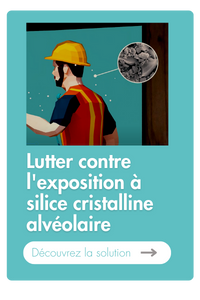Respirable crystalline silica in the construction industry: prevention rather than cure
Summary
Construction sector: Which activities are mainly affected by this exposure?
Link to the study [FR]

At the forefront is the mining and quarrying sector, whose workers have long been known to be affected by silicosis (a lung disease caused by inhalation of crystalline silica dust).
According to the study, the mining and quarrying sites with the highest levels of crystalline silica include:
- Metal ore mine
- Building stone quarry (only for highly siliceous stones)
- Sand and aggregate production quarry
- Slate, clay and kaolin quarry
Some examples of major projects with a greater impact:
- Construction / renovation of road infrastructures
- Tunnel construction site
- Building renovation
The FORSAPRE website, dedicated to occupational health in the construction industry – operated by the national multidisciplinary occupational health grouping for the construction industry (GNMST BTP), details the workplaces likely to be in a risky environment.
- Public works (earthworks, tunnel work, underground work, road planing, asphalt cutting, kerb cutting): various network worker, road mason, earthworker, miner, well-digger, foundryman, driller.
- Quarry work: stone crushing, sand and gravel extraction, stone cutting, diatom calcination
- Railway work (ballasting of tracks) : Mason, earthworker
Exposure risk assessment: what should be measured?
Other organisations, such as the French National Authority for Health, recommend assessing an employee’s exposure risk, among other things to ensure appropriate medical monitoring.
In order to support occupational physicians and the multidisciplinary occupational health team on this topic, the French National Authority for Health published in January 2021, good practice recommendations to identify and estimate the exposure to crystalline silica over the whole working life of an employee.
This report highlights 4 factors :
- The probability of exposure
- Frequency of exposure tasks and actions and intensity of exposure
- Cumulative duration of exposure periods
- The time elapsed since the beginning of the exposure
To gather this information and mention it in the medical file of the employee concerned, the summary of the study proposes to rely on different databases :
- The data available in the occupational health medical file
- The results of exposure measurements provided by the company
- The records of the Updated Work Situation File (FAST),
- The MatGene Crystal Silica Exposure Employment Matrix from Public Health France,
- National Research and Safety Institute’s SOLVEX search engine.
These records are useful references for answering e.g. the probability of exposure but may be useless for calculating the cumulative duration of exposure periods.
Thus, how do you ensure a safe working environment for your employees throughout their working life?
The market for measuring instruments has become interested in the subject of crystalline silica dust. There are now several tools available to identify its presence. However, the measurement methods differ and so does the accuracy of the results.
What are the existing solutions for making these measurements?
The market for measuring instruments can be divided into two main categories: time-delayed devices (called samplers) and real-time devices.
Samplers are more commonly used because they are certified, which gives them a legal value.
One of their particularities is that they quantify each particle by element/chemical agent, which allows a broader spectrum of substances to be scanned. In contrast to real-time tools, samplers rely on physical and chemical measurements for measuring the presence or absence of crystalline silica.
However, there are limitations to the reliability of the results in terms of the actual exposure assessment. The method of measuring a sampler is to take a quantity of dust over a period of time and send it to a laboratory for study. If the sampling rate of the sampler is not high enough, the sample sent for analysis may not be usable.
The other limitation is the concept of average exposure values, based on a sample taken at a point in time. This method does not allow for the detection of exposure peaks and consequently, this may impact the level of protection put in place.
Real-time measurement: enhancing monitoring and alerting to danger
The data collected over a day by the real-time respirable dust sensors (portable or placed at a strategic point), allows to identify among others :
- tasks associated with emissions
- exposure/emission peaks, to give an estimate of exposure
- malfunctions of protective devices (alarms)
Identify crystalline silica for better protection
Thanks to our portable RCS monitor, codeveloped with Ellona, and our NuisAlgo Air platform, you can monitor:
👉 levels of RCS on your operations in real time
👉 alerts in case of peak exposure
👉 cumulative exposure level during the workday (alerts when approaching legal limits – OEL, WEL)
In addition, this mode of operation evaluates the duration of an employee’s exposure as accurately as possible and makes it possible to compare it with the WEL threshold, based on an 8-hour period.
Beyond the risk control aspect, real-time solutions, such as the one proposed by UBY, provide an immediate alert when the threshold is exceeded. The person in charge of site safety can then ensure that the protection methods of the exposed worker(s) are in order or react if necessary.







